Worker Wednesday

Gift of Earl and Elaine Buras, 1999.060.006
Seventy years ago, Delta Shipbuilding Co. in New Orleans launched their fifth Liberty ship, the SS Theodoric Bland.
Post by Curator Content/Specialist Kimberly Guise.


Gift of Earl and Elaine Buras, 1999.060.006
Seventy years ago, Delta Shipbuilding Co. in New Orleans launched their fifth Liberty ship, the SS Theodoric Bland.
Post by Curator Content/Specialist Kimberly Guise.
On 16 May 1942, the Liberty Ship SS Abraham Baldwin, was launched by Delta Shipbuilding Co. in New Orleans.
We have two photographs in our collection that form a “before and after” of the launch.
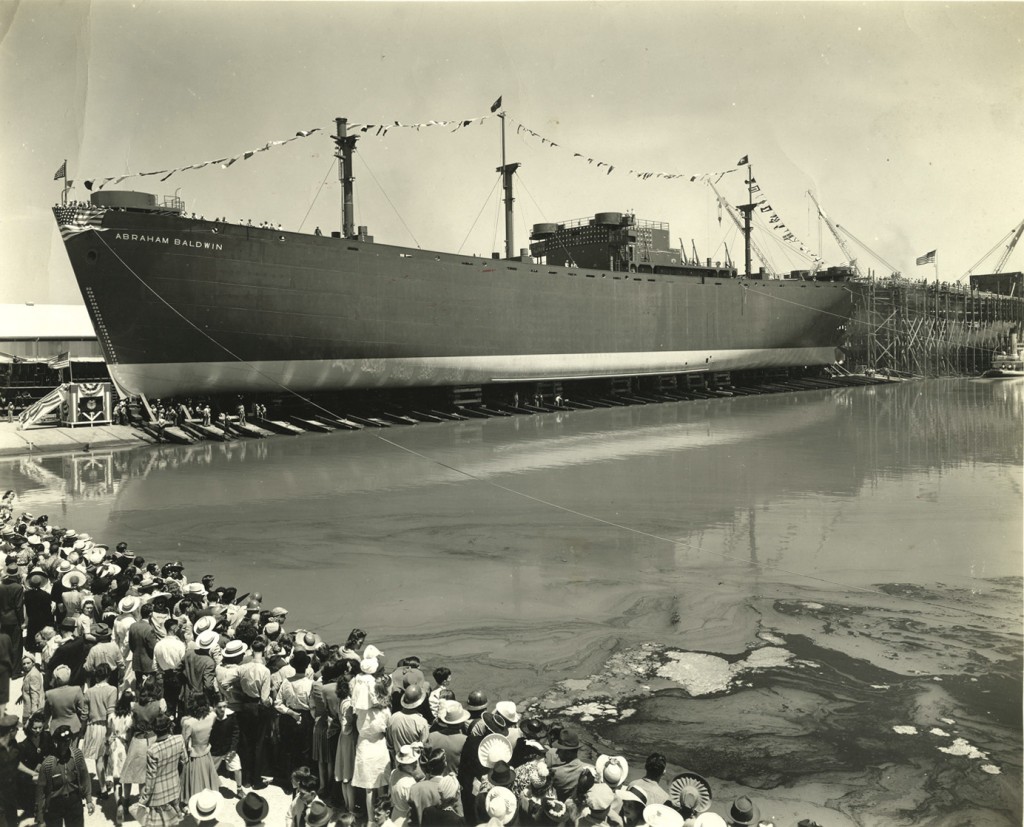
Gift of Earl and Elaine Buras, 1999.060.013

Gift of Jack Hirsch, 2003.022.003
Decades after dodging German U-boats in the Gulf, Liberty ships were intentionally sunk as part of an artificial reef project. The SS Abraham Baldwin was one of the first WWII vessels to be used in such a project in the Gulf of Mexico. She was stripped and sunk off of the coast of Mississippi’s Horn Island in 1976. Artificial reefs, although somewhat contested, have been shown to provide a stable platform for the growth of marine life and aquatic organisms. For more information about Liberty ships serving as artificial reefs see the article, Texas’ Liberty Ships: From World War II Working-class Heroes to Artificial Reefs
Post by Curator Kimberly Guise.
May 1942 was the busiest month of the war for U-boat activity in the Gulf of Mexico. The SS Alcoa Puritan was just one of the vessels that fell victim to a U-boat this month 70 years ago. The May 1942 cover of The Eureka News Bulletin shows a steamship ablaze after an encounter with a U-boat; the steamship’s crew members are adrift in a life raft. On 12 May 1942, the tanker SS Virginia was sunk by U-507 as it entered the mouth of the Mississippi—the closest such attack the Louisiana coast would see during WWII. Twenty-six crewmen were killed.
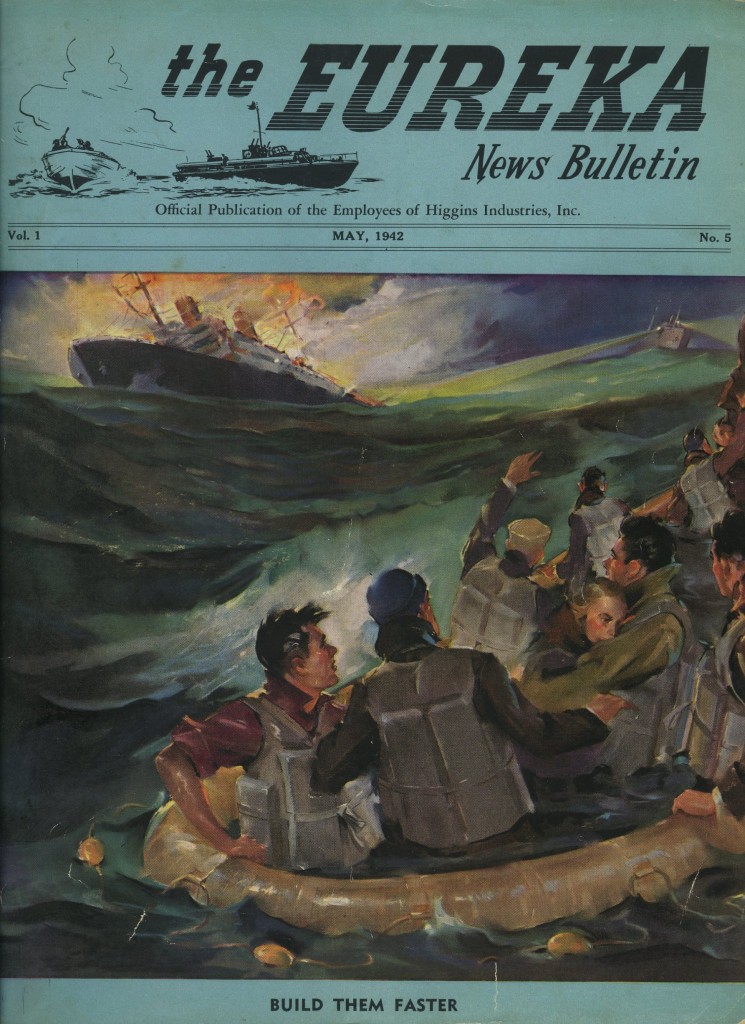
For more posts about the publications of Higgins Industries and production on the home front during WWII, see the series Worker Wednesday.
Post by Curator Kimberly Guise.
On 23 April 1942, Delta Shipyards in New Orleans launched its second Liberty ship, the SS T. J. Jackson, named for the Confederate General better known as “Stonewall” Jackson. The Liberty ship was not the first vessel to be named after Thomas J. ” Stonewall” Jackson, however. France built an ironclad in 1863 for the Confederate Navy which they named CSS Stonewall. Five years later, in 1868, she was sold to the Shogunate of Japan in 1868; for a time, the renamed Kōtetsu was the flagship of the Japanese Navy. The last vessel to be named after General Jackson was the USS Stonewall Jackson SSBN-634, commissioned by the US Navy in 1964.
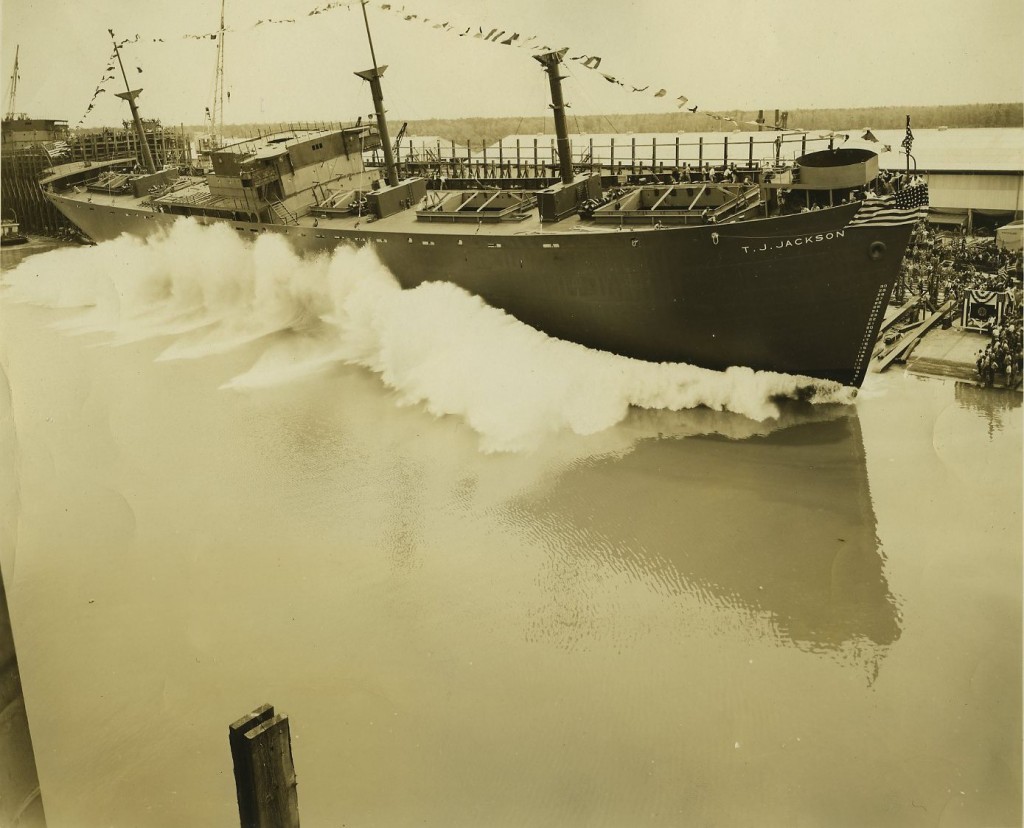
Gift of George Frosch, 2004.009
This post by Curator Kimberly Guise.
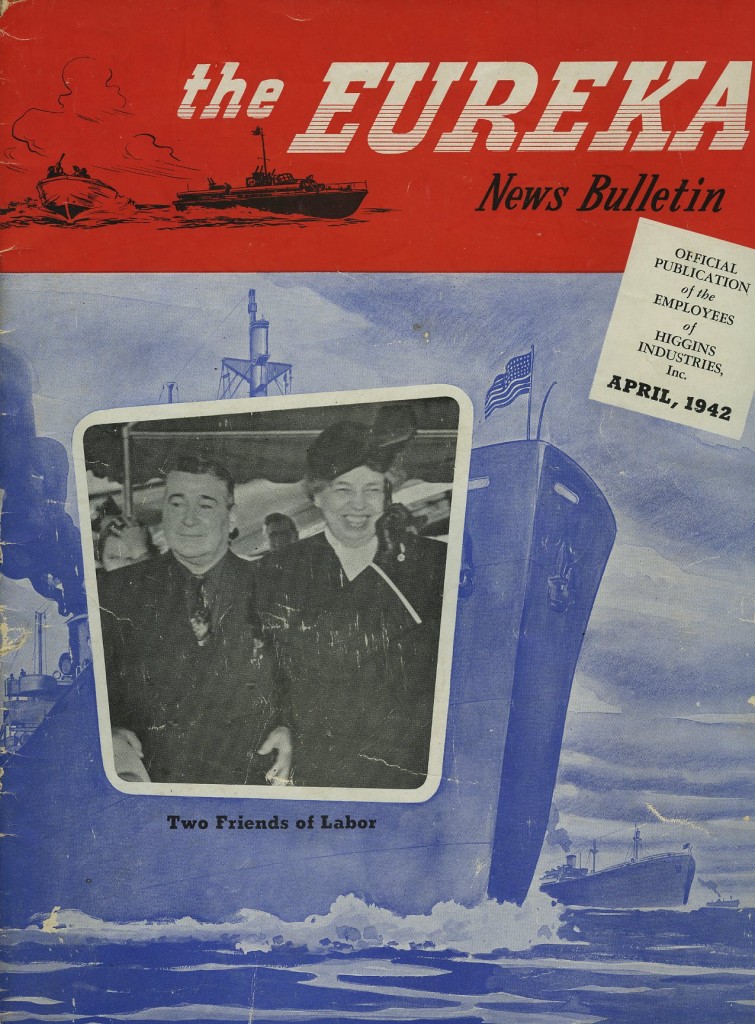
The April 1942 Eureka News Bulletin contained this description of the cover: “Two friends of labor. The first lady of the land, Eleanor Roosevelt, escorted by Andrew Jackson Higgins, arrive in Nashville, Tenn., Sunday, April 19, to attend a labor meeting.”
The meeting they attended was not strictly a labor meeting; it was the third convention of the Southern Conference for Human Welfare (SCHW). Founded in Birmingham, Alabama in 1938, the SCHW was a progressive group focused on uniting black and white citizens and workers in order to tackle social problems and achieve economic stability in the South. The SCHW challenged both the white primaries (primary elections in which African Americans were not allowed to vote) and the poll tax (fee for voting which would not be completely abolished until 1966).
At the meeting in April 1942, over 500 delegates gathered in Nashville’s War Memorial Auditorium. Inside the conference Jim Crow laws were ignored, with white and black delegates sitting side by side. Baritone Paul Robeson spoke and performed. Eleanor Roosevelt presented the Conference’s Thomas Jefferson award for promoting the Jeffersonian ideals of human and social welfare to Mary McLeod Bethune, educator and civil rights leader. Bethune was a close friend of Eleanor Roosevelt and a member of Franklin D. Roosevelt’s “Black Cabinet,” a black advisory board. Bethune even rode with the First Lady to the conference from the airport. In her acceptance speech Bethune remarked on the fights abroad and on the home front: “As the Negro people march into battle they know that there are many hindrances to full participation in the country’s battle for freedom; but march they must, and march they will, because they do understand that every hope they have for full democracy hinges upon the outcome of the war.”
The SCHW would become one of the first inter-racial groups to call for an end to segragation. Although they disbanded in 1948 due to leadership issues and the rise of anti-Communist sentiment, their contribution to the beginnings of the Civil Rights Movement was significant.
This post by Curator Kimberly Guise.
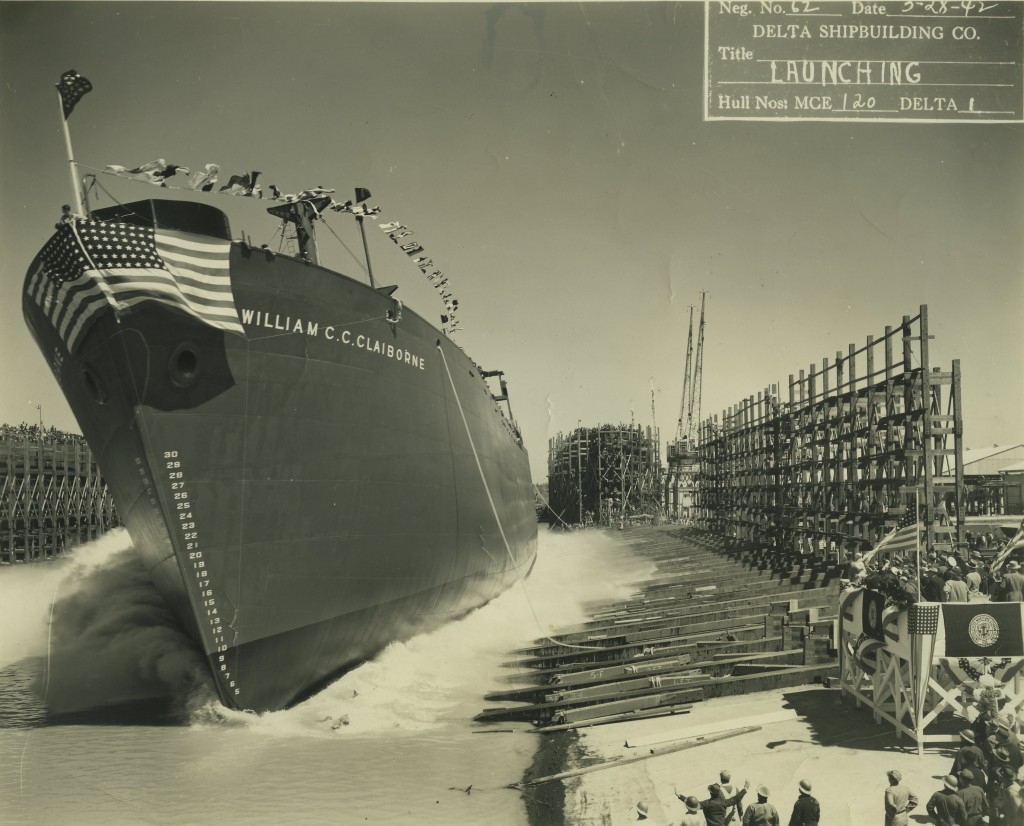
Image Courtesy of Earl and Elaine Buras, 1999.060.007
Seventy years ago today, on March 28, 1942, Delta Shipbuilding Co. in New Orleans launched its first Liberty ship, the SS William C.C. Claiborne, named after the first governor of Louisiana. Delta was one of the nine emergency shipyards established in 1941 by the United States Maritime Commission. Delta would launch a total of 187 Liberty ships (out of 2,710 produced overall) during the war. The average time it took to build one of these massive ships was two months.
This post by Curator Kimberly Guise.
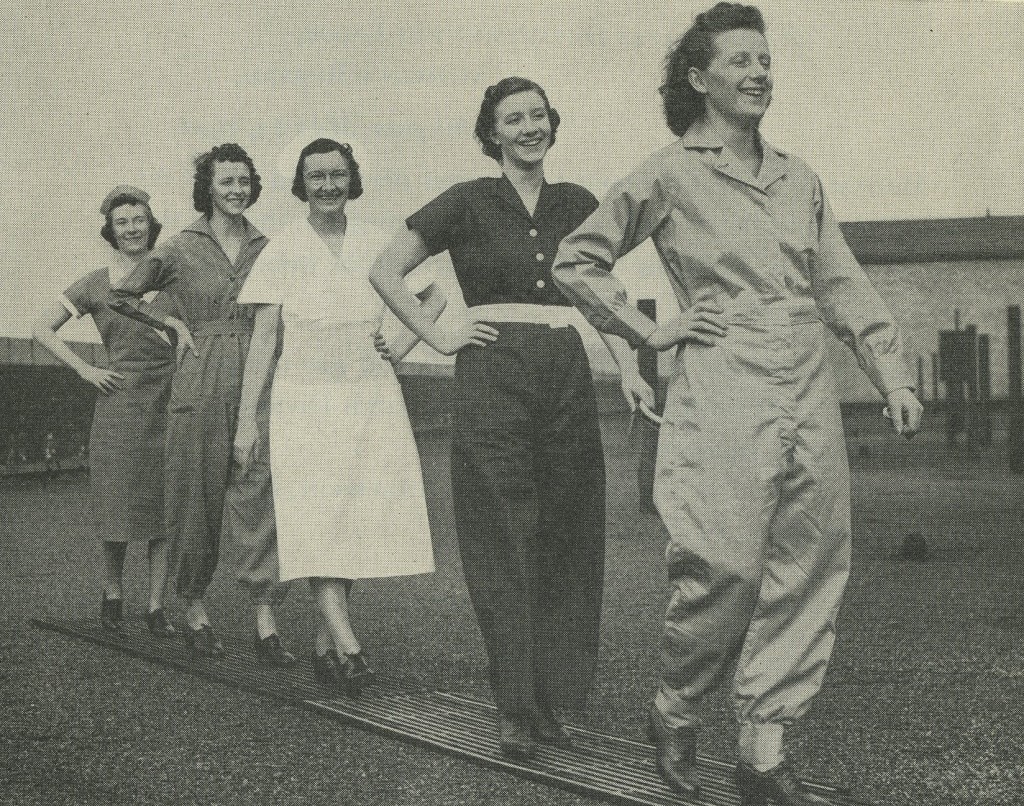
The Bulletin Safety Clothing for Women in Industry published by the Women’s Bureau of the U.S. Department of Labor in 1941 states:
Safety clothing is designed for its attractiveness as well as its utility. It has become fashionable to dress and act so that accidents cannot happen.
The main rules are:
The well-dressed woman in industry is a safe worker.
Clothing suitable to the job helps to avoid accidents.
Consider your feet first.
Wear your goggles; you can’t replace an eye.
Wear a cap around moving machinery.
Work dress must suit the job to be safe.
Hand coverings can prevent skin infection and other injury.
Jewelry has no place in the factory.
Jobs with special dangers require special kinds of work clothing.
This post by Curator Kimberly Guise.
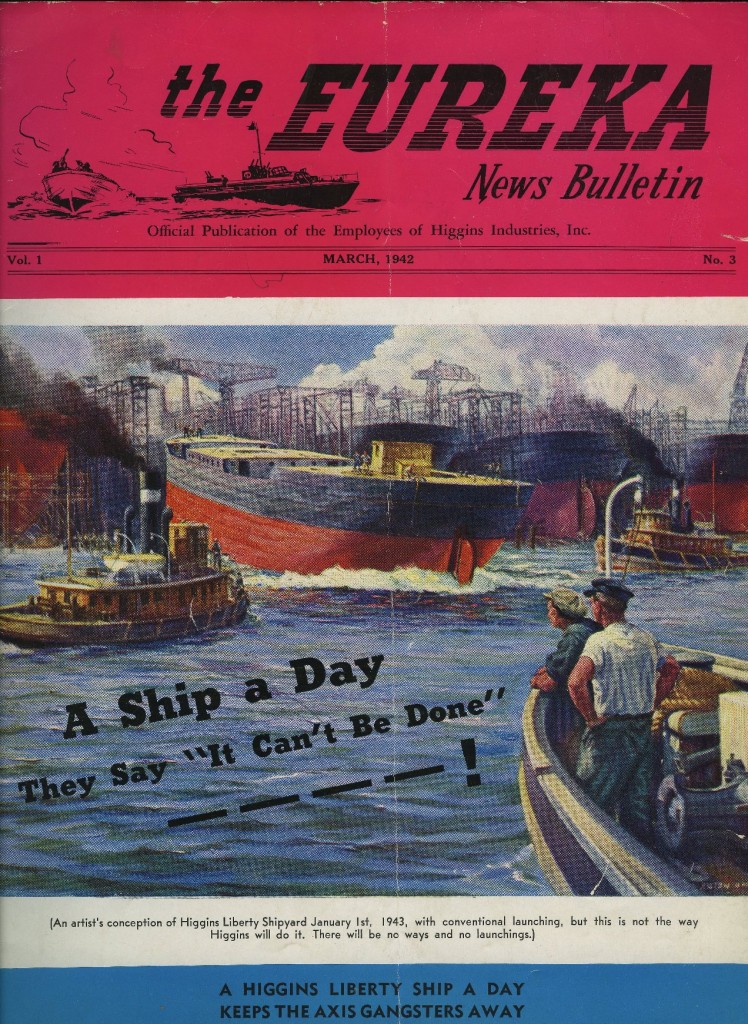
Seventy years ago today, on Saturday, 14 March 1942, Andrew Jackson Higgins returned to New Orleans from a Washington, D.C. business trip. He returned with a U.S. Maritime Commission contract for Higgins Industries in his briefcase for 200 Liberty ships, the massive cargo ships responsible for supplying Allied troops in WWII. Higgins was met at the train station by thousands of employees and friends accompanied by a brass band, welcoming him and the contract home to New Orleans. The contract for 200 Liberty ships was the largest shipbuilding contract ever awarded at the time—an enormous success for the city of New Orleans and a testament to the vision and enthusiasm of A.J. Higgins, who immediately sped up construction of the corporation’s Michoud facility to provide the space necessary to produce the 10,000 ton vessels. The dream of “a Liberty ship a day” would fail to become reality, however, because the much-lauded Liberty ship contract was cancelled in July 1942. Mounting facility costs and doubts as to whether the novice yard could complete the task were cited as reasons for the cancellation. The loss of the contract was to be a huge blow to Higgins and to the city of New Orleans, which Higgins had thought of as a future shipbuilding mecca.
This post by Curator Kimberly Guise.
The Vol. 1, No .2 issue of The Eureka News Bulletin, Higgins Industries company newsletter, dated February 1942, featured a story which sheds light on the birth of the Higgins shop floor rally cry, “The Guy Who Relaxes is Helping the Axis.” Employee George Vanney submitted the slogan, which would live on in photos like the one below. The Eureka News Bulletin and The Higgins Worker are full of such patriotic slogans and poems, many submitted by employees just like Vanney.
Scene from the Higgins Industries City Park shop floor
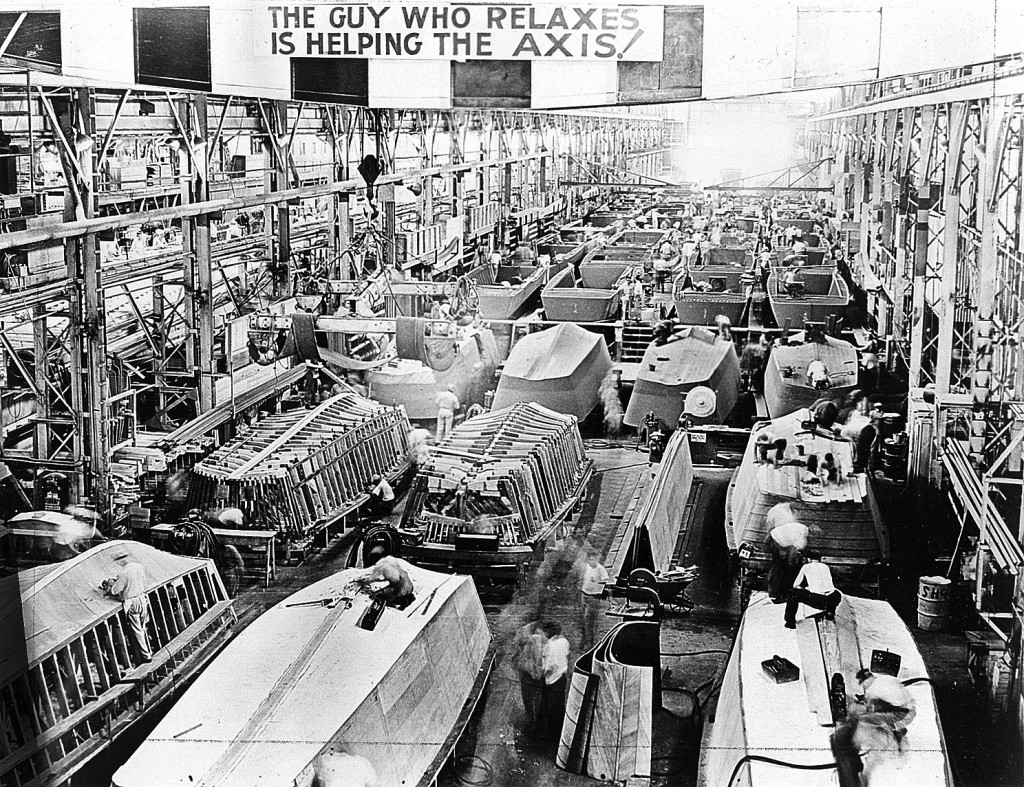
Article from Page 5 of Vol. 1, No. 2 of The Eureka News Bulletin about Vanney’s slogan
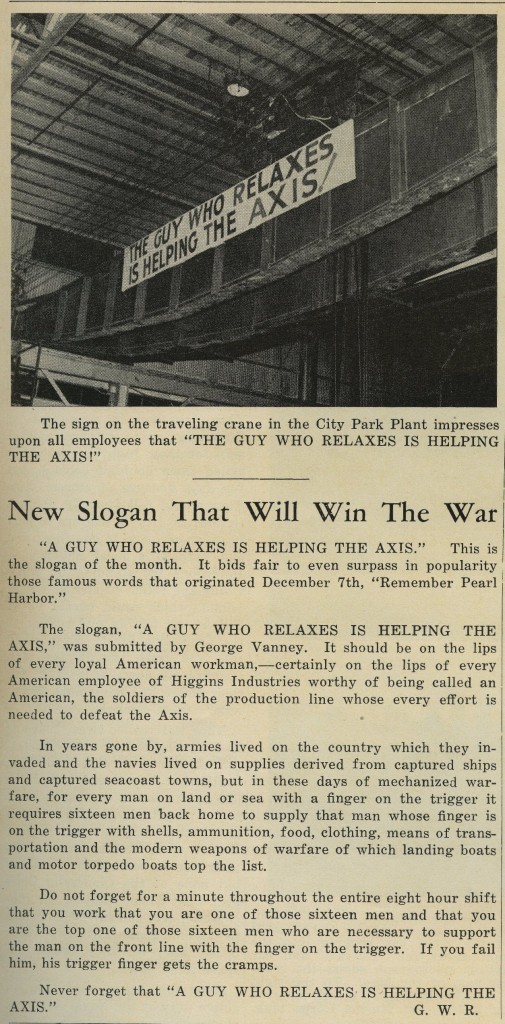
Post by Curator Kimberly Guise

70 years ago this month, Higgins Industries began publishing a newsletter. Initially a monthly magazine entitled The Eureka News Bulletin, the company organ devolved into a weekly bulletin called The Higgins Worker (featured previously in this column). For older entries see the Worker Wednesday Archive.
The Higgins company newsletter was born out of the suggestion of a Higgins employee, electrician Leroy L. Hall, who was awarded a $25.00 Defense Bond for his suggestion. Volume 1 of the Eureka News Bulletin listed an Editorial Staff of ten and included a Women’s Editor, Staff Photographer, Sports Editor, and Hygiene Editor.
Stay tuned for more 70th Anniversary Worker Wednesday entries.
Posted by Curator Kimberly Guise.